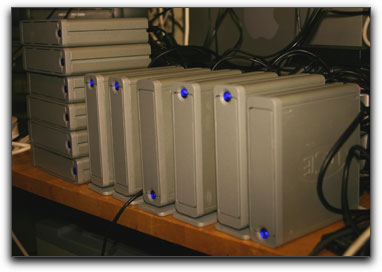

December 18, 2006
RAID IT
MacVideo Magazine
For DV FilmMakers and Video Professionals
www.macvideo.co.uk
By Rick Young
So you've outgrown FireWire drives, you needs loads of space that doesn't run out all the time and you need a way of backing up everything. This is what is possible in the world of storage today and while not cheap - it is certainly a whole lot more affordable than it used to be.
A RAID is basically a bunch of drives striped together - which means they are formatted in such a way that they appear as a single unit on one's desktop. For example if you connect 4 250GB FireWire drives they will appear on your desktop as 4 individual drives - when RAIDED together they appear as one single drive.
The advantages of running a RAID, or several or these, is that the throughput of data is increased and therefore greater transfer rates can be achieved. Also the fact that your drives appear as a single unit makes it easy to store and find things.
The big disadvantage of a RAID is if a single drive fails then you lose everything - a RAID is dependent on all the drives working!
To overcome the above problem one can Mirror a RAID to another RAID. This means the data is written into two places at the same time, which can slow down performance, possibly defeating the purpose of going to the effort of setting up a RAID in the first place. Plus RAIDS cost money so if you mirror a RAID to a RAID then the financial investment is going to be big.
RAIDS can used with many different protocols to transfer data: FireWire, SCSI, SATA - for the rest of this article I will deal with SATA RAIDS and boxes.
SATA - Serial ATA.
ATA is what took over from SCSI. Back in the last century hard drives were very expensive and more difficult to configure than they are today. SCSI required system IDs to be set individually for each drive. Set two SCSI drives with the same ID and your system would freeze. It was a different world and you needed to be deeply technical just to know what you were doing.
Then it all changed. Along came ATA and the drives jumped in size and dropped in price. Suddenly 100GBs seemed like a measly amount. For those who invested in SCSI it was quite a shock . I remember paying £500 for 9GB SCSI drives and then paying £200 for a 37GB IDE drive. The industry changed dramatically.
FireWire developed and prices dropped again. As all this was taking place there was a shift in the requirements of users out there in the land of video production. What was once cut on tape was now done non-linear and the demand was there for uncompressed video which required faster drives. While it can be done using FireWire drives (I have done it myself!) for reliability in broadcast environments something more robust was needed. Many still used SCSI which is rock solid but still expensive. And then even more space was needed because everything suddenly went HD. So the world turned to SATA.
SATA gives excellent performance with tremendous reliability - just the same as the internal drives inside your G5 or Mac Pro tower. One can set up many drives inside of a single box which can then be formatted individually or RAIDED together. When formatted individually the drives can be physically changed on removable Caddies. Think of it like changing gigantic floppy discs or Zip or Jaz cartridges....
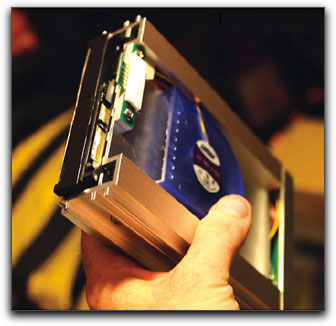
Note: Fan on each caddy.
Here's a look at 3 separate RAID boxes and how they perform.
S-Box-P RAID
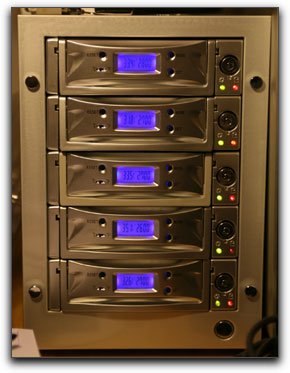
This is the largest of the units tested and has been designed to house, protect and individually cool each of the drives inside of the case. Every drive is screwed to a caddie with a fan per drive to cool it down. The temperature readout on each of the caddies shows the internal temperature in either Fahrenheit or Celsius. A standard computer lock which operates with a generic key is used to lock or unlock each of the drives.
The caddies are well-built and not flimsy in any way. It is easy to remove or replace a drive and these caddies are well-priced. This is a well-thought out box which I have had running for months without any problems what-so-ever. It also runs very quiet.
Available in the UK from Apple Doctor,
London. Phone: 0208 890 9421
Email breffni@appledoctor.co.uk
Sonnet Fusion 500
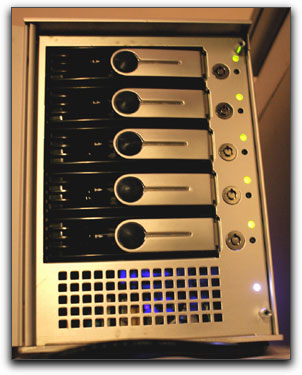
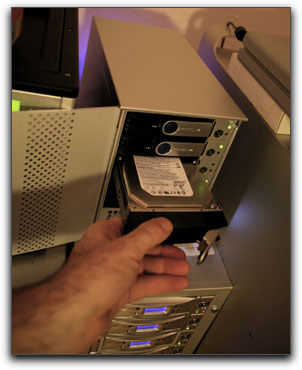
This box in much smaller than the S-Box. It also houses 5 drives which can be RAIDED together or formatted individually. The drives on this box can be changed by pressing a button which is spring-loaded. The procedure is simple and straightforward. The caddies are simple in design and function.
With the Fusion 500 I have noticed a build-up of dust sucked through from the fan at the back of the unit. I saw no performance problems and this is more of an observation than a criticism.
I ran this box alongside the S-Box RAID for a period of months with both of these plugged into the same SATA Port Multiplier PCI card in my G5 tower and both work perfectly.
A Port Multiplier SATA card gives you several SATA buses straight out the back of your Mac. The card I was using gives 4 ports, and each of the boxes hold 5 drives, thus one could have a total of 20 drives fed into your Mac. Fill each of these up with mixture of drives, some RAIDED some formatted individually, and perhaps some mirrored, and you have a very flexible, reliable and powerful hard drive solution.
Weibtech RT5 - uses IDE drives
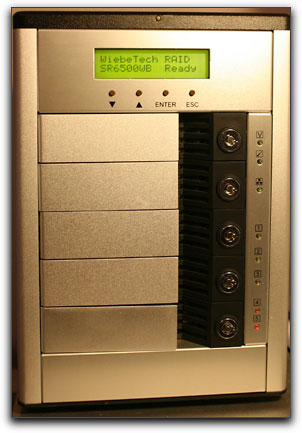
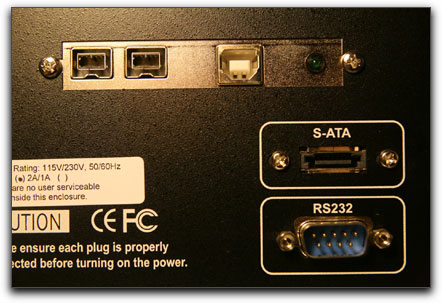
The Weibtech RT5 Hardware RAID supports FireWire, USB and SATA
This is a different sort of a box. This is a hardware RAID. With both the S-Box and Sonnet Fusion 500, to make a RAID is achieved in software - the drives are formatted either individually or RAIDED together using Apple's disc utility. With a hardware RAID this means that whatever you tell the box to do it will do - independent of the computer. Basically you instruct the box through it's own internal software to behave in a certain way.
Hardware RAIDS - the RAID controller is built into the box while with software RAIDS the control is done through the software in the computer. It is also worth noting that hardware RAID cards can also be purchased.
When working with software RAIDS one can only mirror or stripe - with hardware raids one can create a mirror of stripes. www.ammicro.co.uk
One could argue that a hardware RAID is better than a software RAID though I found them both to be absolutely reliable.
The big advantage to the Weibtech is that it has FireWire, USB and SATA protocols on the box, making it the most versatile of the units tested. It is also more expensive than the other boxes.
The Weibtech is very heavy - to call it luggable is no exaggeration.
Conclusion
For my money I have bought into SATA technology because it gives me endless storage with drives on removable caddies than be can easily swapped. I've used each of the above units for DVCam, HDV and DVCPro HD and each handled these tasks without even trying. I now have both a storage and a backup solution which is rock-solid and reliable. SATA drives are cheap to buy and easy to implement into ones workflow. This, in my opinion, is the way forward.
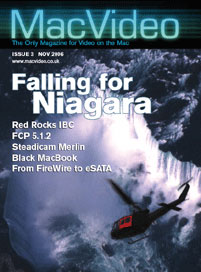 MacVideo Magazine
MacVideo Magazine
For DV FilmMakers and Video Professionals
Published Quarterly
Printed magazine DVD included - $59.95US £ 29.95UK
Electronic version (PDF) $19.95US £ 12.95UK
Both subscription versions include access to the MacVideo web site.
www.macvideo.co.uk
[Top]
copyright © Rick Young 2006
This article first appeared on MacVideo Magazine and is reprinted here with permission.
© 2000 -2006 Apple
Computer, Inc. All rights reserved. Apple, the Apple logo, Final
Cut Pro, Macintosh and Power Mac
are either registered trademarks or trademarks of Apple. Other
company and product names may be trademarks of their respective
owners.
All screen captures, images, and textual references are the property and trademark of their creators/owners/publishers.










 MacVideo Magazine
MacVideo Magazine